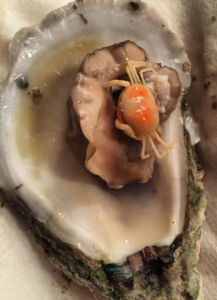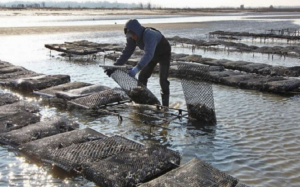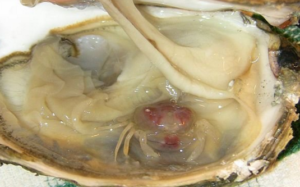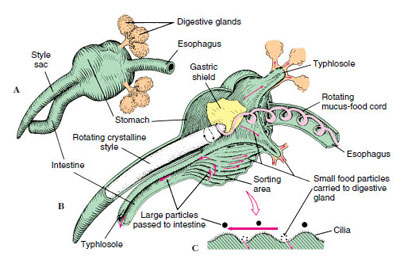
Barnegat Bay is home to oysters and several species of crabs including Pea Crabs
Pea Crabs Family Pinnotheridae
Pinnotheres is a genus of crabs, including the pea crab, also called the oyster crab.
Many species formerly in Pinnotheres have been placed in new genera, such as Zaops ostreus (formerly Pinnotheres ostreus), the oyster crab.
Basically two scientific (Latin) names for the same crab.
Pea Crab or Oyster Crab species osterium
Pea crabs/oyster crabs are small soft-bodied crabs that live in bivalves such as oysters and mussels, attach to echinoderms like sand dollars and other bottom dwellers. <see image>
 Pea crabs are about a half an inch across, and lives inside the gills of an oyster host.
Pea crabs are about a half an inch across, and lives inside the gills of an oyster host.
They uses the oyster for protection and feed mainly on the particulate food material strained from the water by the oyster’s food sorting mechanism.
It is a symbiotic relationship but the oyster doesn’t really benefit (commensalism).
 Pea crabs are kleptoparasites, which means they “steal” food from their host to survive.
Pea crabs are kleptoparasites, which means they “steal” food from their host to survive.
The crab faces away from the gill with its carapace under the normal gills in order to efficiently take the food brought in for the oyster.
In order to maintain the crabs’ position its dactyli (tips) of one or more of the eight (8) walking legs often pierce the gill tissue.
Pea crabs find their oyster hosts very early on when both are still larvae.
They spawn a month after oysters, which allows them to find oyster spat settled out of the water column.
Pea crabs are free-swimming in the early stages to seek out their oyster hosts.
Females remain attached to an oyster but males remain free-swimming for life to find mates from oyster to oyster.
This primarily happens to oyster in the wild. Farm raised oysters is a bit of a different story…
Aquaculture raised oysters have less of a problems with pea crabs for a few reasons:
 2)
2)
Farm raised oyster spat or seed may be put in racks, bags, or cages which are held above the bottom to grow out to market size.
Pea crabs are walking crabs (not swimming) so elevated oysters would be harder to reach and settle into.
Image from Forty North Oyster Farm. https://www.fortynorthoysters.com/
Fun Fact – like most other crabs, their exoskeleton (shell) turns red when cooked.
 1)
1) 
